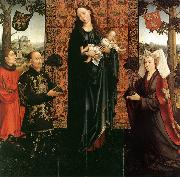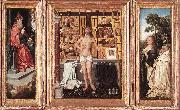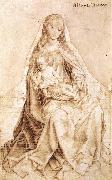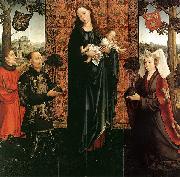WEYDEN, Goossen van der Huiler la Reproduction de TableauAll WEYDEN, Goossen van der Oil PaintingsFlemish painter (b. ca. 1465, Bruxelles, d. after 1538, Antwerpen) |
|||

|
|||
|
|
|||
|
||||||||||||
| WEYDEN, Goossen van der Flemish painter (b. ca. 1465, Bruxelles, d. after 1538, Antwerpen) |
||||||||||||
|
|
||||||||||||
| ID de tableau:: 7238 Le Cadeau de Kalmthout The Gift of Kalmthout 1511 Pétrole sur le panneaude chêne, 153 x 153 cm Staatliche Médité, Berlin 1511 Oil on oak panel, 153 x 153 cm Staatliche Museen, Berlin |
||||||||||||
|
|
||||||||||||
| ID de tableau:: 7239 le Triptyque d-Abbé Antonius Tsgrooten Triptych of Abbot Antonius Tsgrooten 1507 Pétrole sur le panneau, 33.7 x 25.2 cm (le panneau central), 34 x 11 cm (chaque panneau latéral) Koninklijk le Musée voor Schone Kunsten, Anvers 1507 Oil on panel, 33,7 x 25,2 cm (central panel), 34 x 11 cm (each side panel) Koninklijk Museum voor Schone Kunsten, Antwerp |
||||||||||||
|
|
||||||||||||
| ID de tableau:: 62435 Virgin with the Blessing Child Virgin with the Blessing Child 1450-55 Metalpoint on white paper mounted on pink-coloured sheet, 216 x 133 mm Museum Boijmans Van Beuningen, Rotterdam The Virgin is seated between two columns which stand on a low wall, probably intended as walled loggia or hall with behind it in the middle an opening flanked by columns, as Van der Weyden painted in his St Luke painting the Virgin. The situation is strongly reminiscent of the configuration of nearly all of Memling's enthroned Virgins, so that one wonders whether this drawing might not reflect the ultimate prototype of Memling's formula. This conclusion is further enhanced by the position of the Child who, seated on one of his mother's hands and gently restrained with the other, is turning sideways in an attitude of blessing. This is also Memling's basic motif. The high finish of the modelling and draperies and the summary treatment of the architectural setting seem to suggest a copy drawn by the master himself of the main figure of one of his own paintings. The drawing would thus have been intended as a studio model which later ended up in Bruges workshops. It is impossible, however, to `reconstruct' Van der Weyden's lost painting from the derived versions, which are far too divergent; in some the Mother and Child are worshipped by one or two founders, in others they are surrounded by holy women or flanked by angels. The inscription 'Alberto Durer' at top left is a later addition from the 19th century 1450-55 Metalpoint on white paper mounted on pink-coloured sheet, 216 x 133 mm Museum Boijmans Van Beuningen, Rotterdam The Virgin is seated between two columns which stand on a low wall, probably intended as walled loggia or hall with behind it in the middle an opening flanked by columns, as Van der Weyden painted in his St Luke painting the Virgin. The situation is strongly reminiscent of the configuration of nearly all of Memling's enthroned Virgins, so that one wonders whether this drawing might not reflect the ultimate prototype of Memling's formula. This conclusion is further enhanced by the position of the Child who, seated on one of his mother's hands and gently restrained with the other, is turning sideways in an attitude of blessing. This is also Memling's basic motif. The high finish of the modelling and draperies and the summary treatment of the architectural setting seem to suggest a copy drawn by the master himself of the main figure of one of his own paintings. The drawing would thus have been intended as a studio model which later ended up in Bruges workshops. It is impossible, however, to `reconstruct' Van der Weyden's lost painting from the derived versions, which are far too divergent; in some the Mother and Child are worshipped by one or two founders, in others they are surrounded by holy women or flanked by angels. The inscription 'Alberto Durer' at top left is a later addition from the 19th century |
||||||||||||
|
|
||||||||||||
| ID de tableau:: 89487 The Gift of Kalmthout The Gift of Kalmthout 1511(1511) Medium oil on oak panel cyf 1511(1511) Medium oil on oak panel cyf |
||||||||||||
|
|
||||||||||||
|
| Artiste précédent Artiste prochain | |||||||||||
|
|
||||||||||||
|
WEYDEN, Goossen van der Flemish painter (b. ca. 1465, Bruxelles, d. after 1538, Antwerpen) |
||||||||||||
|
|
||||||||||||
|
CONTACTER DES Etats-Unis |









